Source
Moral -> Guilty -> Emotion
Parameter-Efficient Fine-Tuning for Large Models: A Comprehensive Survey https://arxiv.org/abs/2403.14608
Towards a Unified View of Parameter-Efficient Transfer Learning https://arxiv.org/abs/2110.04366
LLMs from scratch - very good and well written example
煉丹五部曲
-
應用 (起死回生,長生不老,美顔):analytic (spam, sentiment) or generative (summarization)
-
靈材:datasets, tokenizer, embedding
-
丹方:model
-
丹爐:Nvidia GPU (和財力有關)
- 煉製:training: data_loader, loss function, optimizer
- Fine-tune pre-trained model
- 評估:evaluation: accuracy, BLEU
我們現在討論 step 4.1, Finetune pre-trained model!
微调:大型语言模型通常在下游任务上进行微调,方法是在预训练模型的顶部添加特定任务的层。这个微调过程调整了嵌入和其他模型参数,以提高目标任务的性能。
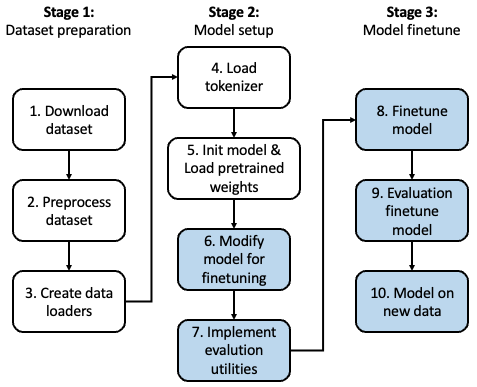
Why (Full parameter) Fine-Tuning or Parameter Efficient Fine-Tuning
Training from scratch 需要 (1) 大量的 data (Giga words, Tera words, …), D; (2) 大量的 resources (算力,內存,和時間) ~ D (Data) x W (model size).
如果是算力 bound, D x W ~ 算力 x 時間。如果是內存頻寬 bound ~ 內存頻寬 x 時間。大多情況是算力和內存頻寬兩者都有影響。
Full (parameter) fine-tune pre-trained model 在 training 最大的好處是: 不需要大量的 data, 只需要少量的 data (Kiko words or Mega words?),i.e. (D -> 小 D). 所以另一個附加的好處是不需要大量的算力。但仍然需要同樣的內存以及內存頻寬 for model storage and access. 對於 inference 完全沒有沒有影響。
而 Parameter Efficient FT 只調整部分的參數 (W -> 小 W,一般是幾 %)。對於 training, 節省更多的算力和内存頻寬。但是對於 inference 則不一定。在某些情況可能完全沒有影響 (e.g. selective parameter fine tuning, LoRA merge the parameter),也有可能多出算力。(e.g. adaptor, LoRA of parallel computation)
| from scratch | Full fine tuning | Adaptor | Selective | LoRA | Soft Prefix | |
|---|---|---|---|---|---|---|
| Training | $D \times W$ | $\Delta D \times W$ | $\Delta D \times \Delta W$ | $\Delta D \times \Delta W$ | $\Delta D \times \Delta W$ | $\Delta D \times \Delta W?$ |
| Inference | $W$ | $W$ | $W + \Delta W$ | $W$ | $W$ or $W+\Delta W$ | $W \times 1.0?$ |
-
D 是完整的 data, W 是 model weight.
-
software prefix 的 context length 會變長,所以 inference computation 會變多。
一般對於 from scratch vs. full fine tuning 的討論沒有問題。因爲差異很大。對於 full fine tune vs. PEFT 則有不同的意見。有一部分人認爲 full fine tuning 所花的時間和 PEFT 沒有差太多,而且只是 one-time. 反而 inference 時要多計算。因爲 inference 發生的頻率遠高於 training, 所以傾向 full fine tuning. 不過對於 edge fine tune,PEFT, 特別是 LoRA 還是可以節省大量算力。另外 LoRA 還可以 enable multiple applications. 因此 PEFT 還是顯學!
PEFT 的分類
先說 baseline: Full Fine Tuning, 或是 full tuning. 即是在 pre-tune network 的基礎上,可以調整所有的參數,但是不改變 network topology.
PEFT (parameter efficient fine tuning): 只調整(或是加入)部分的參數 for downstream work.
- Adaptor: physical layer 插入原來的網路。會改變原來的 network topology,以及加入新的參數,所以效果最好?
- Software prefix: 在 prompt 直接加上 finetune parameter。不會改變原來的網路和參數,所以效果最小?
- LoRA: 只是改變部分參數,不會改變 network topology. 所有效果介於之間?
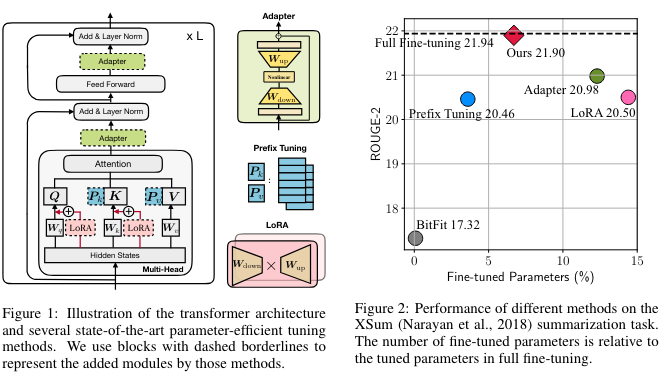
LoRA Fine-Tune
LoRA 使用兩個 Low Rank matrix, A and B, 作爲 fine tune parameters.
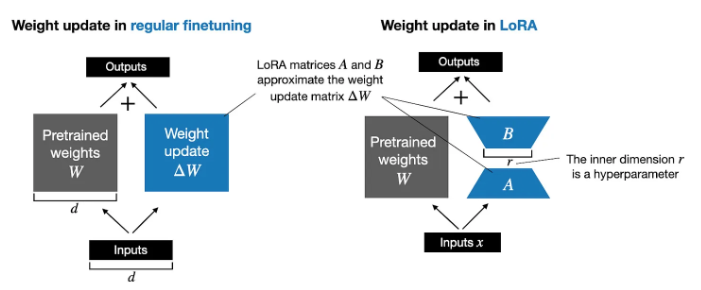
- 在 training 或是 full fine-tuning, 或是更準確 back-prop phase: $W_{updated} = W + \Delta W$.
- 在 PEFT 的 LoRA 中,$W$ is frozen, $\Delta W \approx A B$. $W_{updated} = W + A B$. $A, B$ 的初始值為 0, 而不至於影響原來的結果。
- 在 inference phase, 或是 forward phase, $x(W+\Delta W) = x(W+AB)$. 有兩種計算方法,一個是把 $AB$ 合入 $W$, 好處是不會有額外的計算。另一種方法是分開計算最後整合。 $x(W+\Delta W) = xW+xAB$. 壞處是額外的計算和内存以及内存頻寬。好處是保留原來的 base model. 所以可以有多個 LoRA 切換。
- LoRA 可以調整的部分一般包含:feedforward layer, output layer, 以及 attention block 中的 K, Q, (and V?) mapping layers.
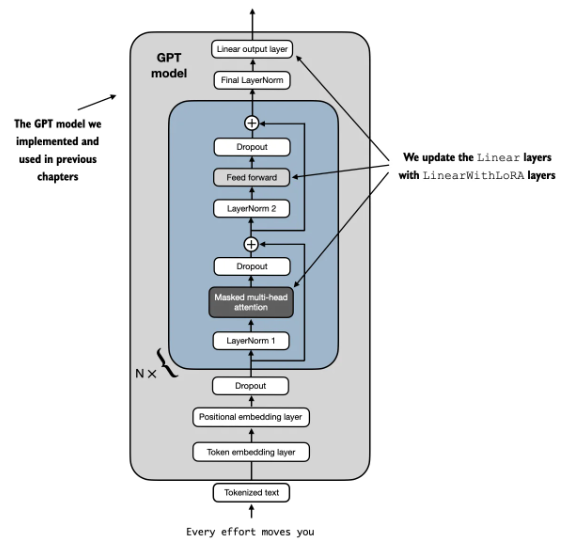
以下是不同的 PEFT 在 LLM 的結果。LoRA 的效果最好,接近或超過 full fine tune。而且對 trainable parameter size 很 robust.
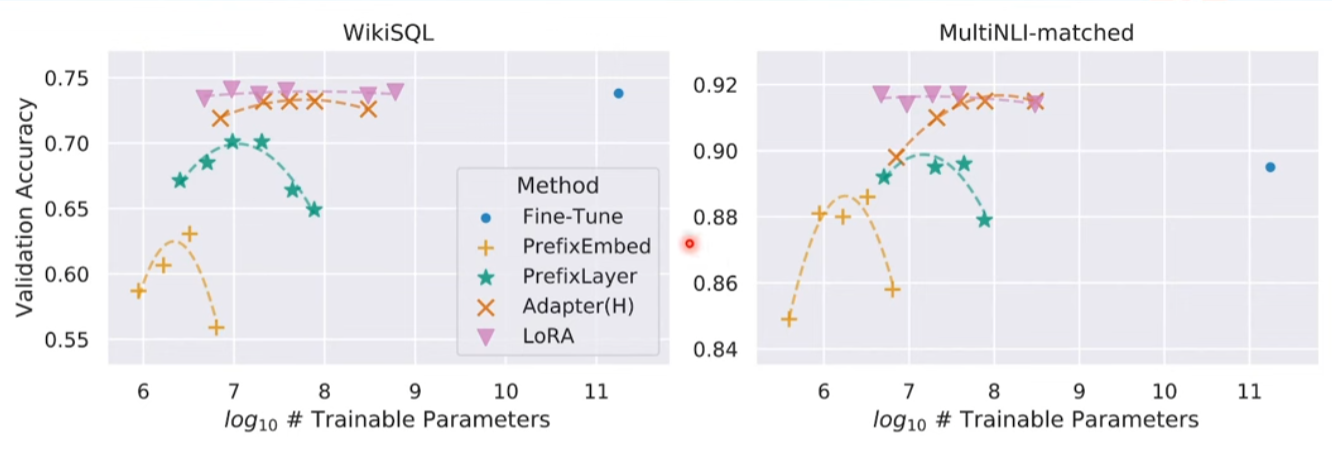
更細的分類:
- Adaptor: serial, parallel, hybrid.
- LoRA (reparameter): LoRA, DoRA, DyLoRA
- 加一個子類:selective fine tuning
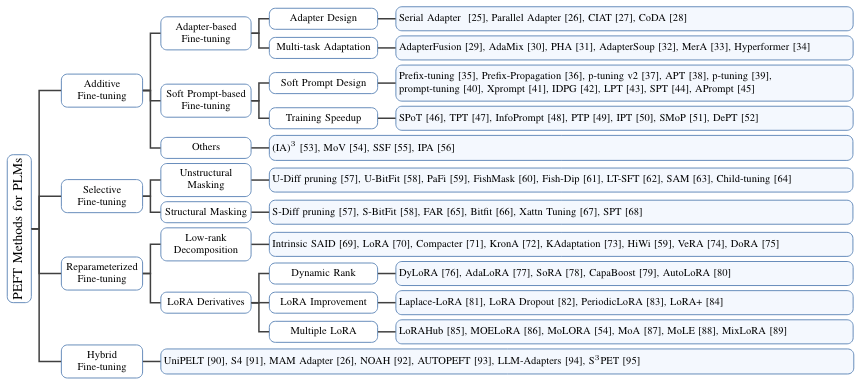
PEFT 的 Unified View

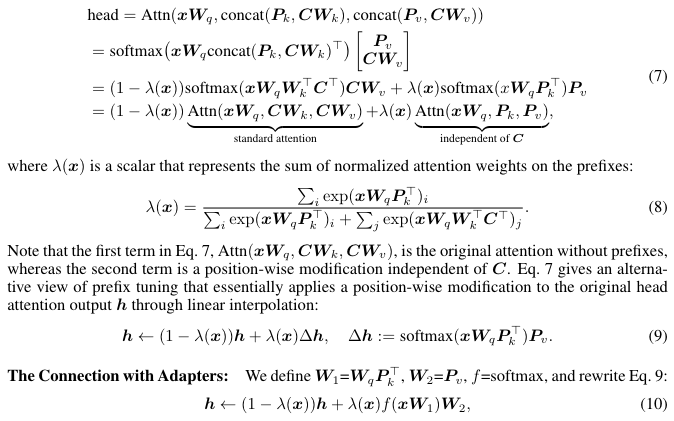

PEFT 的實例 :
我們使用 GPT2-small model 作為 PEFT 例子。
GPT2 原始的 model size: emb_dim: 768, n_layers: 12, n_heads: 12. 總參數量:124M (可以參考 LLM parameter excel file).
LLM 直接用 Text Classification
LLM 可以不需要 retrain 或是 fine-tune 直接回答一個訊息是否為 spam,稱為 0-shot. 也可以直接在 prompt 提供 k 個例子,稱為 k-shots. 不過這種無需 retrain/fine-tune 方式和 LLM 本身的能力有關,基本上 LLM 需要比較大的模型 (7B or above) 經過適當 data 的訓練才有比較好的結果。以 GPT2 (124M) 為例,結果並不令人滿意。
Fine-tune 則是一個非常好的方法讓小型 LLM 處理特定領域任務 (domain specific task)
1 | |
1 | |
修改 LLM for 文本分類
在開始微調之前,我們先對 LLM 做個小手術。把原來文本輸出 ‘yes, this is a SPAM’, 變成 binary output, 0: negative, 1: positive.
小手術包含兩個 dimensions: (1) embedding (spatial) dimension, 50257 vocab 變成 2 binary; (2) token context (temporal) dimension, 取出第一個 (或是最後一個) token?

修改 embedding (spatial) dimension
不過第一步是修改最後 output layer (linear, no softmax?) 從 $768 \to50257$ 變成 $768\to2$,如下圖。
Q: no softmax at the output?
A: No, model 的 output 是 logits. 在 training 時,會用 cross-entropy loss function 作 back-prop. Cross-entropy 本身就類似 softmax function. 在 inference 時,只要 sample 最大值,也不需要 softmax. Softmax output 一般是要提供分類機率值,常用於 computer vision. LLM 似乎非常少用 softmax as output。
1 | |

修改 token context (temporal) dimension
修改 embedding layer model 後的 input 和 output:
- Input tensor shape: (batch_size=1, input_num_tokens). [1,4] in the following case.
- Output tensor shape: (batch_size=1, output_num_tokens, num_classes=2). [1, 4, 2] in the following case. 為什麼 output token number 剛好也等於 4? 巧合嗎?
1 | |
因此我們取出最後一個 token 作為最後的 output,也就是 outputs[:, -1, :] = [-3.5983, 3.9902] 。
1 | |
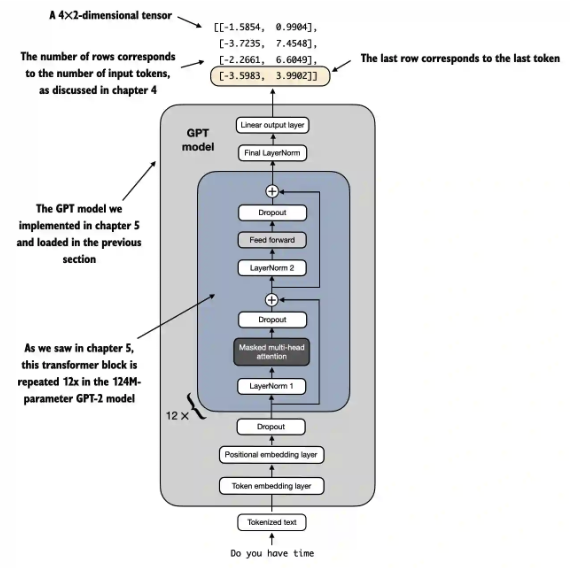
我們定義微調的 loss function (這和 LLM training 的 loss function 不同)。
重要和微妙:model output, i.e. logits 是用 one-hot format (01, 10) 代表 2 classes. 但是 target_batch 中的 label 卻是 binary format (0: spam negative; 1: spam positive). 理論上計算 loss function,需要把 target_batch 的 binary format 轉換成 one-hot format. 不過 torch 的 cross-entropy loss 會自動處理這個轉換。對 binary classes 或是 multiple classes 分類看起來比較簡潔。
1 | |
我們同樣定義 accuracy function by sampling the maximum output. 如前所述,我們不用 softmax 計算機率。只用 argmax 取最大值。
1 | |
沒有微調的分類結果應該接近盲猜,也就是 50%.
1 | |
接下來就是 PTFE, 也就是微調。
Selective fine-tuning
最簡單的 selective fine-tune 就是 fine tune 最後的 output layer(s)。其實這是早期 ML 的 transfer learning。
不過把最後的 transformer layer h[11], 和對應的 LayerNorm layer 一起 Fine tune, 效果更好。
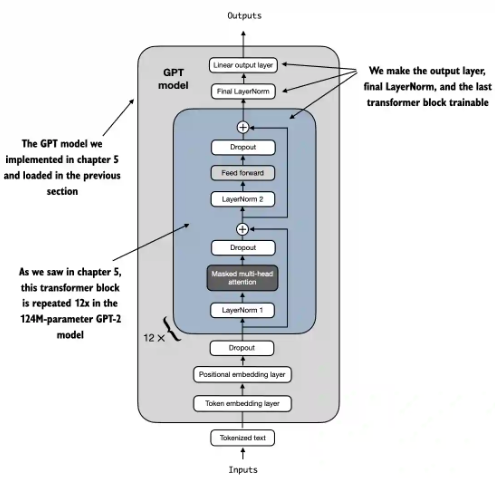
1 | |
- 可調的參數:7.1M, 比起 142M, 約為 5.7%.
- Fine-tune 之後的 test accuracy ~ 90%.
1 | |
LoRA
如前所述,LoRA 是用 AB low rank matrix 做微調。
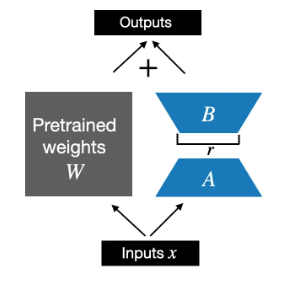
我們對使用 LoRALayer 取代原來的 Linear Layer: transformer 中的 Feed forward, attention block 的 K,Q,(and V?), 以及 output layer.

以下是需要修改的 code.
1 | |
原始的 GPT2 model 是 124M.
1 | |
LoRA 的 trainable parameter: 1.3M. 比例只有 1%!.
1 | |
LoRA 的 accuracy ~ 98% 看起來還不錯!
1 | |